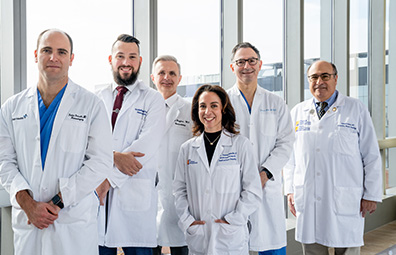Rathke’s Cleft Cysts
Rathke’s cleft cysts (RCC) are non-cancerous, fluid-filled cysts that develop between the parts of the pituitary gland at the base of the brain. These rare tumors – which comprise less than one percent of all brain tumors – are believed to develop while a fetus is growing in the womb. They can affect the adjacent pituitary gland and optic nerve, so treatment may require coordination among specialists.

Meet Our Brain Tumor Care Team
Meet the specialists at the Gerald J. Glasser Brain Tumor Center who are experts in treating Rathke’s cleft cysts.
Meet the TeamSymptoms
Most Rathke’s cleft cysts are small and rarely cause symptoms or problems during childhood. They are usually diagnosed in adulthood when symptoms occur due to compression of the surrounding pituitary gland and optic nerves. Symptoms can include:
- Visual problems, especially peripheral vision loss
- Pituitary hormone deficiency resulting in developmental delay, short stature, obesity and other hormonal problems
- Headaches
- Nausea
Diagnosis
Rathke’s cleft cysts are diagnosed by a patient’s symptoms, physical exam and specialized testing. Specialized testing may include:
- Endocrine assessment – Blood tests are used to evaluate the patient’s hormone levels and determine if the pituitary gland is functioning normally. An endocrinologist may be consulted at this stage.
- Ophthalmic assessment – An ophthalmologist may examine the patient’s eyes and perform a visual field test to determine if the tumor is affecting clarity of vision or impairing peripheral vision.
- Imaging studies – A variety of scans are used, like computed tomography (CT), magnetic resonance imaging (MRI) with contrast dye or magnetic resonance angiogram, a type of MRI that uses a magnetic field and pulses of radio-wave energy to provide pictures of blood vessels inside the body.
Treatment
Observation – Most small and non-symptomatic Rathke’s cleft cysts can be observed over time with surveillance MRI scans.
Surgical drainage – used when larger cysts cause significant symptoms. A neurosurgeon and ear, nose and throat surgeon who specialize in skull base surgery collaborate to drain the cyst through minimally invasive endoscopic skull base techniques using a three-dimensional model of the brain and skull base (stereotactic guidance). This procedure can usually be done without damaging the normal pituitary gland.
Our team will closely monitor you and personalize your follow-up care. Our patient navigator will also connect you with our support group and other resources.